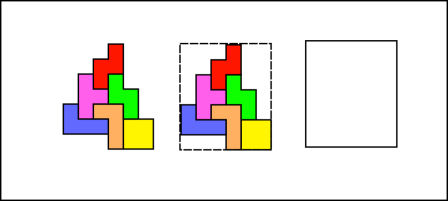Fancified name in the title aside I was checking out some worksheets for geogebra yesterday and came across one which had predefined tetris block elements. I played around building different shapes, originally wondering if you could make a periodic pattern out of an even ditribution of tetris blocks but I eventually landed on a different question which will be the topic of this prost.
So you start with the 7 basic tetris blocks as featured in the image below. So these pieces you can stick together into chunks in an amazing number of ways and each new figure naturally has some circumference. Assuming all the pieces fit rogether in one chunk the maximal circumference such a figure can have is 56 (think about it) but the question quickly becomes: What is the least circumference such a composite piece can have?
So these pieces you can stick together into chunks in an amazing number of ways and each new figure naturally has some circumference. Assuming all the pieces fit rogether in one chunk the maximal circumference such a figure can have is 56 (think about it) but the question quickly becomes: What is the least circumference such a composite piece can have?
Here are some of the initial trial and error solutions which I played around with
 but there nevertheless is a packing with even smaller circumference and it is proving the existence and minimality of this packing that will be the theme of this post.
but there nevertheless is a packing with even smaller circumference and it is proving the existence and minimality of this packing that will be the theme of this post.
So after some fiddling I arrived at the following close packing of tetris blocks which has a circumference of 22 units.
 It seems pretty suggestive that this is the smallest circumference you can arrive and arguing it is pretty straight forward. For this I chose to use the concept of a bounding rectangle. For any packing shape you can enclose it in a rectangle whose sides run parallell to the sides of the shape.
It seems pretty suggestive that this is the smallest circumference you can arrive and arguing it is pretty straight forward. For this I chose to use the concept of a bounding rectangle. For any packing shape you can enclose it in a rectangle whose sides run parallell to the sides of the shape.

The circumference of the rectangle is always equal or smaller than that of the tetris shape which is I suppose easiest to prove by sending horizontal and vertical rays across the shape and counting the number of times it crosses the boundary which is at minimum 2.
We now turn our attention to the areas of the tetris blocks. Five have area 3, one has area 8 and one has area 4 which sums up to a total area of 28. What rectangles can contain such an area and do any of them have circumference smaller than 22?
Let and
be supposed sides of a rectangle which has circumference smaller than 22 and still has area greater than 28. This gives us the following set of equations:
There are multiple ways of showing that there are no solutions to this problem but I’ll just do proof by case checking running though all the relevant cases. first of all constrains at least one of n and k to be greater than
so we run though
with corresponding k:s such that n+k<11.
(n,k): n*k
(6,1): 6
(6,2): 12
(6,3):18
(6,4):24
(7,1): 7
(7,2): 14
(7,3): 21
(8,1) : 8
(8,2): 16
(9,1): 9
None of these cases produce an area greater than 28 so the conditions are incompatible and 22 indeed is the minimal circumference.
Hi! Your “24” configuration, the red block is an “s-block” when it should be a “z-block”. The green “s-block” is already used on that config, as well. Have you found any other way for a 24 configuration
Huh. You’re right. Probably messed that one up because the mirror and rotate buttons in inkscape are right next to eachother. Most of these posts are one-offs I don’t spend much time on but I do remember there being quite a few configurations or each number so you’ll find them if you go looking. Here’s one I threw together now: http://imgur.com/0V5sjEb [contained in a 6×6 box so 6+6+6+6=24 circumference]
Nevertheless, thanks for pointing it out.